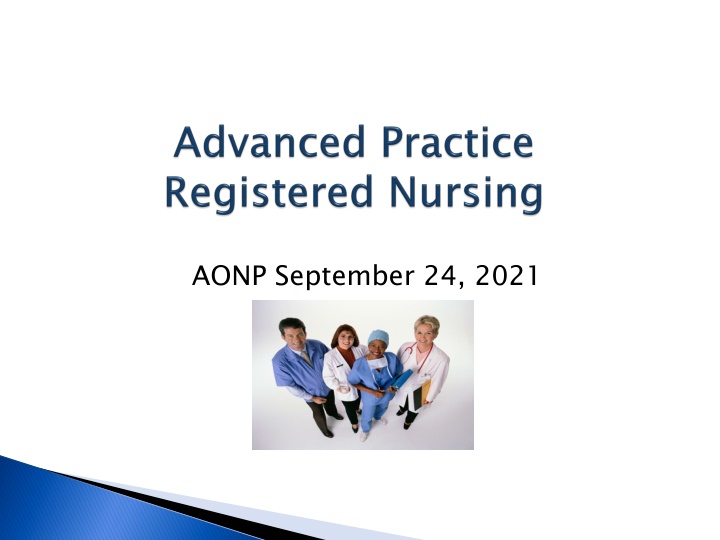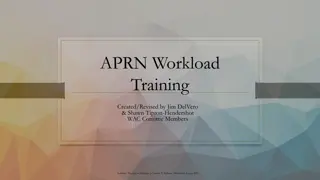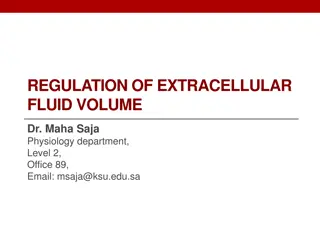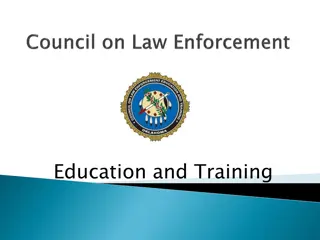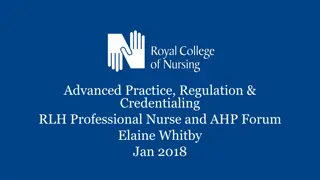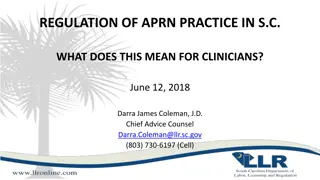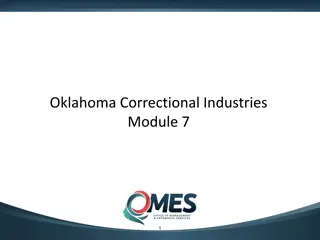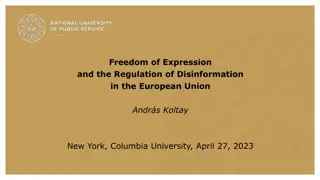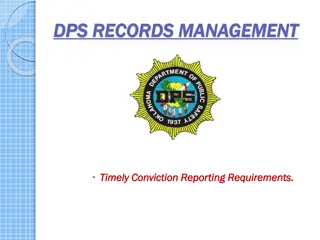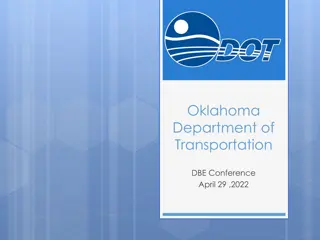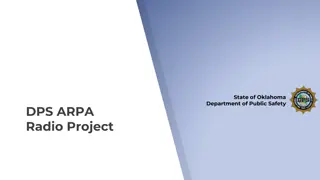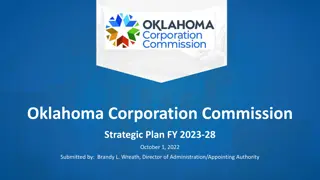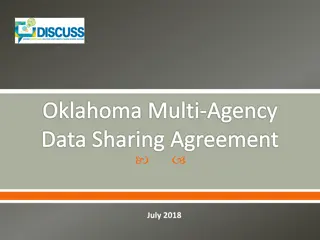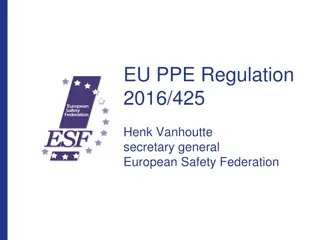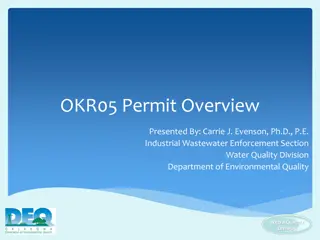Overview of APRN Regulation and Practice in Oklahoma
This content delves into the regulation and practice of Advanced Practice Registered Nurses (APRNs) in Oklahoma. It covers who regulates nursing practice, the roles and populations of APRNs, examination of laws related to CNP practice, approved certifications for APRN licensure, and updated legislation affecting APRNs. Details on the Oklahoma Nursing Practice Act, rules for licensure, grounds for disciplinary action, and the role of the Oklahoma Board of Nursing are also highlighted. Additionally, it discusses the requirements for APRNs and provides statistics on the number of licensed APRNs in Oklahoma.
Download Presentation

Please find below an Image/Link to download the presentation.
The content on the website is provided AS IS for your information and personal use only. It may not be sold, licensed, or shared on other websites without obtaining consent from the author.If you encounter any issues during the download, it is possible that the publisher has removed the file from their server.
You are allowed to download the files provided on this website for personal or commercial use, subject to the condition that they are used lawfully. All files are the property of their respective owners.
The content on the website is provided AS IS for your information and personal use only. It may not be sold, licensed, or shared on other websites without obtaining consent from the author.
E N D
Presentation Transcript
APRN-CNPs will: Define who regulates nursing practice in Oklahoma Summarize the 4 APRN roles and 6 populations Examine the Nursing Practice Act and Rules related to CNP practice Analyze the different certifications approved for APRN licensure. Review updated legislation impacting APRNs.
Public Protection Through Nursing Regulation 59 O.S. 567.2 Public Protection Through Nursing Regulation
Oklahoma Nursing Practice Act and Rules provide: The legal basis for nursing practice including Advanced Practice Registered Nurses Requirements for Licensure Grounds for Disciplinary action NPA [59 O.S. 567.1,et seq] and Rules [OAC 485] can be viewed on the OBN website.
Oklahoma Board of Nursing Regulates: Advanced Practice Registered Nurses (APRNs) Advanced Practice Registered Nurses (APRNs) Registered Nurses (RNs) Licensed Practical Nurses (LPNs) Advanced Unlicensed Assistants (AUAs) [567.2.A.1]
An APRN is a licensed Registered Nurse who has: Completed an APRN graduate level education program to acquire advanced clinical knowledge and skills focusing primarily on the direct care of individuals; Passed a national certification exam in an APRN specialty area/population focus specialty area/population focus; and Obtained from the OK Board of Nursing a license as an APRN in one of the following roles: CRNA, CNP, CNM, CNS [59 O.S. 567.3a(5)]
5,344 APRNs licensed in OK (FY2021) Compared to FY 2020, increase of 217 4,396 have prescriptive authority (FY 2021) Compared to FY 2020, increase of 286
The APRN education program is a graduate level program offered by an accredited university. The APRN education program must prepare the graduate to practice in one of the 4 APRN roles (CRNA, CNP, CNM, CNS) and in at least one of the six population foci: Family/Individual Across the Lifespan Adult/Gerontology (acute and/or primary) Neonatal Pediatric (acute and/or primary) Psychiatric/Mental Health Women s Health/Gender Related
Must be licensed in one of the four roles: Certified Registered Nurse Anesthetists (784) Certified Nurse Midwife (74) Clinical Nurse Specialist (289) Certified Nurse Practitioner (4,197)
Must pass an approved certification exam http://nursing.ok.gov/prac-natlcert.pdf 17 approved certification examinations for initial licensure: 11 for CNP 4 for CNS 1 for CRNA 1 for CNM 11 for CNP
Certified Nurse Practitioner (CNP) is APRN who performs in an expanded role in the delivery of health care: consistent with advanced education as a CNP in an area of specialty functions within the CNP scope of practice for a selected area of specialization, and is in accord with the standards for CNPs as identified by the certifying body and approved by the Board. [59 O.S. 567.3a(6)]
Effective November 1, 2011, each APRN must use the title Advanced Practice Registered Nurse or APRN and the role for the type of APRN license held (CNP, CNM, CNS, or CRNA). Examples: APRN-CNP or APRN, CNP The APRN may choose whether to use additional certification or education credentials. APRN, CNP, FNP-BC
APRN performs in an expanded role based on: education and preparation for one of the 4 roles certification for role and a specialty area in at least one of the 6 population foci 59 O.S. 567.3a (5) (6) (7) (8) (9) (10) OAC 485: 10-15-6 (b) Scope of Practice for CNP 4 roles specialty area in at least one of the 6 population foci Scope of Practice for CNP Decision Making Model for Scope of Practice Decisions, # P-10 http://nursing.ok.gov/prac-decmak.pdf
The Decision-Making Model is a tool that can be used to help licensed nurses determine their personal scope of practice. Application of the guideline is accomplished through answering seven questions. The intent of the guideline is to present a process to determine acts appropriate to nursing at various levels. Can be located on the OBN website @ http://nursing.ok.gov//prac-decmak.pdf
OK APRN license can be verified on the OBN website including: Certification Prescriptive authority Supervising physician s name
Features: Nurse Portal Account License/Certificate Applications License/Certificate/Rx authority Renewal License Verification Submitting a Complaint Name/Address change Message Center
No the APRN must hold a separate prescriptive authority recognition. CNPs, CNSs authority recognition. (must utilize the Exclusionary formulary) CNPs, CNSs, and CNMs CNMs are eligible for prescriptive Exclusionary CRNAs and administer drugs. (must utilize the Inclusionary Formulary) CRNAs are eligible for authority to select, order, obtain, Inclusionary Prescriptive authority can be identified on the website under license verification.
CNM CNS CNP CRNA Independent practice except RX/authority writes orders and prescriptions Exclusionary Formulary Collaborative practice Writes orders Inclusionary Formulary 59 O.S. 567.4a 59 O.S. 567.4b
Submits a completed application for each type of recognition and fee Licensed as an RN and APRN Holds a graduate degree or higher from an APRN accredited education program Has completed 3 academic semester credit hours or 45 contact hours of education within the last three years, targeting APRNs and other prescribers, in pharmacotherapeutics, clinical applications, and the use of pharmacological agents Submits an agreement with a supervising OK-licensed physician [59 O.S. [59 O.S. 567. 4a and OAC 485: 10 567. 4a and OAC 485: 10- -16 16- -3] 3]
Name, title, address, and phone number of APRN prescribing Name of the physician who is supervising prescriptive authority Name of the client Date of the prescription Full name of the drug, dosage, route and specific directions for administration DEA number of APRN, if required
Application for renewal of prescriptive authority shall: Be concurrent with the two-year RN and APRN licensure renewal; Include: Completed application and fee Documentation of 15 contact hours or 1academic credit hour of education in pharmacotherapeutics New rules will require 2 additional contact hours regarding risk of addiction and prescribing opioids for those APRNs (CNP, CNS, CNM) with a DEA and OBNDD permits; and Written statement sign by supervising physician. OAC 485:10-16-6
Rules established by the Oklahoma Board of Medical Licensure and Supervision [435:10-13-2] or the Oklahoma Board of Osteopathic Examiners [510: 10-4-3] Full and unrestricted licensure with DEA and OBNDD permits Active(MD) clinical practice w/patient contact at least 20 hours per week Trained and fully qualified in the APRN specialty M.D. may supervise no more than 6 FTE APRNs/PAs; D.O. no more than 4 FT midlevels (APRN and PA). Boards may make an exception to this number upon request by the physician.
Supervision of an Advanced Practice Registered Nurse with prescriptive authority means overseeing and accepting responsibility for the ordering and transmission by a Certified Nurse Practitioner, a Clinical Nurse Specialist, or a Certified Nurse-Midwife of written, telephonic, electronic or oral prescriptions for drugs and other medical supplies, subject to a defined formulary [59 O.S. 567.3a(12)]. The supervising physician should regularly and routinely review the prescriptive practices and patterns of the advanced practice nurse with prescriptive authority [OAC 435: 10-13-2] or [510:10-4-2].
Hospital using non-physician practitioners, such as PAs, APRNs, psychologists, or other practitioners, shall clearly define the role, limitations and mechanism of supervision in their job description, contract, or bylaws, as appropriate, to insure compliance with state law and good-practice standards for each practitioner. [OAC 310:667-5-2] Staff of the hospital shall be licensed or registered in accordance with applicable state laws and shall provide care according to the requirements of their respective practice Acts. [OAC 310:667-5-1]
Licensed Independent Practitioner means any individual permitted by law and by the licensed hospital to provide care and services, without direct supervision, within the scope of the individual s license and consistent with clinical privileges individually granted by the licensed hospital. LIPs may include APRNs with prescriptive authority, physician assistants, dentists, podiatrists, optometrists, chiropractors, and psychologist. [OAC 310:667-1-2]
APRNs (CNP, CNM, CNS) may not schedule I or II controlled dangerous drugs. [63 O.S. 2-312.C] not order or prescribe Must comply with state Enforcement Administration (DEA) requirements prior to prescribing controlled and dangerous drugs. Apply for OBNDD permit (state) Apply for DEA permit (federal) state and Federal Federal Drug No more than 30-day supply for schedule III-V drugs shall by prescribed by the APRN with Rx authority unless there is a more restrictive law. [OAC 485:10-16-5.(c)]
If the term doctor is used by a licensed nurse holding appropriate educational credentials, such usage must be in accordance with 59 O.S. 725.1, et seq. and OAC 485:10-13-1.(e) DNP is not one of the 9 classes of persons in 59 O.S. 725.2; however, there is additional language. Any other person using the term doctor, or any abbreviation thereof, shall designate the authority under which the title is used or the college or honorary degree that gives rise to the use of the title. [59 O.S. 725.2 (B)]
Senate Bill 388 passed, approve by Governor April 27, 2021 Home Care Services shall be certified by a healthcare provider Healthcare provider includes APRN-CNP and APRN-CNS Shall apply to any certification conducted on or after March 27, 2020
House Bill 2009 passed, approved by Governor April 19th, 2021 Allows for APRNs to sign Death Certificates Effective November 1, 2021 Signing is electronic and training is provided by the OSDH
Gina Stafford, BSN, RN Associate Director for Nursing Practice Oklahoma Board of Nursing (405) 962-1840 Office (580) 272-7265 Cell
